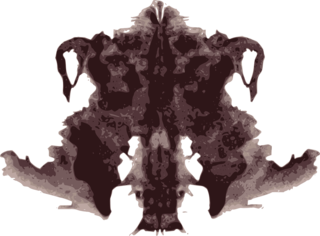Psychosis
Assessing Perceptual Disturbances With the Rorschach
Could an 'old-school' test be useful in identifying thought disorders?
Posted July 20, 2022 Reviewed by Kaja Perina
Key points
- Early, subtle perceptual disturbances predict later psychosis.
- The Rorschach Inkblot Test detects early perceptual disturbances.
- The Rorschach Inkblot Test captures neurophysiological processing as evidenced by recent neuroimaging studies.
- The Rorschach Inkblot Test could be used as an early detection tool in schizophrenia and related psychoses.

The Rorschach Inkblot Test (RIT) was developed in 1921 by Swiss Psychiatrist Hermann Rorschach. While working in an inpatient psychiatric hospital, Rorschach experimented with upwards of 40 inkblots. In doing so, he noticed that patients with schizophrenia responded differently to the inkblots than those with other disorders. Today, this projective test measures personality and perception by way of complex coding systems and standardized administration carried out by trained psychologists.
Despite its continued popularity, the RIT remains under constant scrutiny due to its unorthodox approach and inherent subjectivity. In fact, a primary argument against the RIT stems from the erroneous belief that interpretations are made informally and without a systematic consensus. The RIT has also been criticized on the basis of its internal validity, or its ability to measure what it purports to. While arguments against the RIT endure, research has demonstrated that it remains an invaluable tool for assessing psychotic disorders such as schizophrenia (Kleiger & Mihura, 2021).
Schizophrenia is a serious mental illness characterized by thought disorder and other perceptual disturbances. New research suggests that individuals at high risk for psychosis display subtle perceptual disturbances early in the prodromal period (Keane, Cruz, Paterno, & Silverstein, 2018). Assessing for perceptual disturbances may be a key to early detection for those at risk of developing schizophrenia or a related disorder.
How could an inkblot test assess and detect subtle perceptual disturbances?
Research over the past decade has attempted to establish a neurophysiological basis to understanding variables on the RIT. A seminal study published in 2010 described activation of so-called mirror neurons in response to “feeling movement” evoked from RIT cards. This was the first time mirror neuron activation was noted in response to an ambiguous, static stimulus (Giromini et al., 2010).
Similarly, researchers in 2017 conducted an fMRI study to assess the neurophysiological basis of the RIT. The findings suggest that participants engaged during the RIT displayed higher temporo-occipital and fronto-parietal activations, in addition to greater activity in sub-cortical regions such as the limbic system when compared to a control group. This finding supports the notion that the RIT involves higher order visual processing (both top-down and bottom-up), as well as perceptual processing of emotions (Giromini et al., 2017).
What does this mean for early detection of schizophrenia and related psychotic disorders?
We know that early detection of schizophrenia and related psychotic disorders is key to treatment success. Research suggests that perceptual and thought disturbance is likely a prime indicator of later psychosis vulnerability. The RIT is uniquely capable of detecting subtle perceptual disturbances, and has an established evidence bank of identifying deficits in visual form perception (Kimhy et al., 2007). Therefore, more routine use of the RIT in at-risk populations would likely be beneficial.
References
Giromini, L., Porcelli, P., Viglione, D. J., Parolin, L., & Pineda, J. A. (2010). The feeling of movement: EEG evidence for mirroring activity during the observations of static, ambiguous stimuli in the Rorschach cards. Biological psychology, 85(2), 233-241.
Giromini, L., Viglione Jr, D. J., Zennaro, A., & Cauda, F. (2017). Neural activity during production of Rorschach responses: An fMRI study. Psychiatry Research: Neuroimaging, 262, 25-31.
Keane, B. P., Cruz, L. N., Paterno, D., & Silverstein, S. M. (2018). Self-reported visual perceptual abnormalities are strongly associated with core clinical features in psychotic disorders. Frontiers in psychiatry, 9, 69.
Kimhy, D., Corcoran, C., Harkavy-Friedman, J. M., Ritzler, B., Javitt, D. C., & Malaspina, D. (2007). Visual form perception: a comparison of individuals at high risk for psychosis
Kleiger, J. H., & Mihura, J. L. (2021). Developments in the Rorschach assessment of disordered thinking and communication. Rorschachiana, 42(2), 265.


